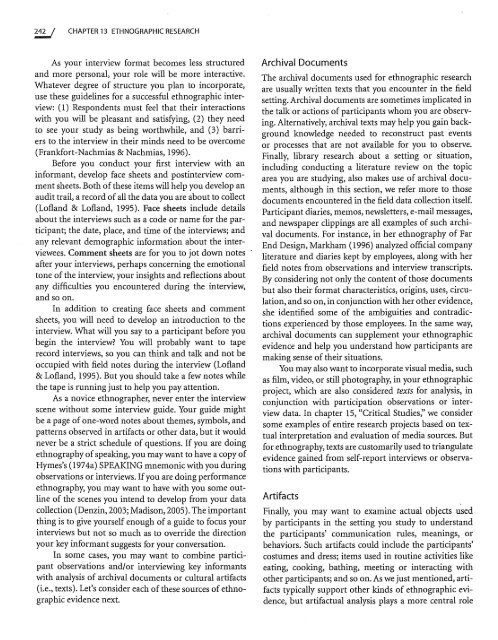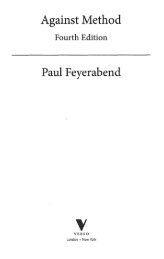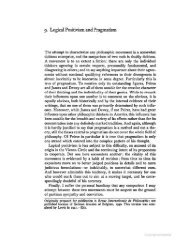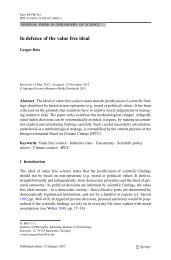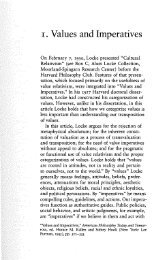Ethnographic Research - Matthew J. Brown
Ethnographic Research - Matthew J. Brown
Ethnographic Research - Matthew J. Brown
- No tags were found...
You also want an ePaper? Increase the reach of your titles
YUMPU automatically turns print PDFs into web optimized ePapers that Google loves.
242 I CHAPTER 13 ETHNOGRAPHIC RESEARCHAs your interview format becomes less structuredand more personal, your role will be more interactive.Whatever degree of structure you plan to incorporate,use these guidelines for a successful ethnographic interview:(1) Respondents must feel that their interactionswith you will be pleasant and satisfying, (2) they needto see your study as being worthwhile, and (3) barriersto the interview in their minds need to be overcome(Frankfort-Nachmias & Nachmias, 1996).Before you conduct your first interview with aninformant, develop face sheets and postinterview commentsheets. Both of these items will help you develop anaudit trail, a record of all the data you are about to collect(Lofland & Lofland, 1995). Face sheets include detailsabout the interviews such as a code or name for the participant;the date, place, and time of the interviews; andany relevant demographic information about the interviewees.Comment sheets are for you to jot down notesafter your interviews, perhaps concerning the emotionaltone of the interview, your insights and reflections aboutany difficulties you encountered during the interview,and so on.In addition to creating face sheets and commentsheets, you will need to develop an introduction to theinterview. What will you say to a participant before youbegin the interview? You will probably want to taperecord interviews, so you can think and talk and not beoccupied with field notes during the interview (Lofland& Lofland, 1995). But you should take a few notes whilethe tape is running just to help you pay attention.As a novice ethnographer, never enter the interviewscene without some interview guide. Your guide mightbe a page of one-word notes about themes, symbols, andpatterns observed in artifacts or other data, but it wouldnever be a strict schedule of questions. If you are doingethnography of speaking, you may want to have a copy ofHymes's (1974a) SPEAKING mnemonic with you duringobservations or interviews. If you are doing performanceethnography, you may want to have with you some outlineof the scenes you intend to develop from your datacollection (Denzin, 2003; Madison, 2005). The importantthing is to give yourself enough of a guide to focus yourinterviews but not so much as to override the directionyour key informant suggests for your conversation.In some cases, you may want to combine participantobservations and/or interviewing key informantswith analysis of archival documents or cultural artifacts(i.e., texts). Let's consider each of these sources of ethnographicevidence next.Archival DocumentsThe archival documents used for ethnographic researchare usually written texts that you encounter in the fieldsetting. Archival documents are sometimes implicated inthe talk or actions of participants whom you are observing.Alternatively, archival texts may help you gain backgroundknowledge needed to reconstruct past eventsor processes that are not available for you to observe.Finally, library research about a setting or situation,including conducting a literature review on the topicarea you are studying, also makes use of archival documents,although in this section, we refer more to thosedocuments encountered in the field data collection itself.Participant diaries, memos, newsletters, e-mail messages,and newspaper clippings are all examples of such archivaldocuments. For instance, in her ethnography of FarEnd Design, Markham (1996) analyzed official companyliterature and diaries kept by employees, along with herfield notes from observations and interview transcripts.By considering not only the content of those documentsbut also their format characteristics, origins, uses, circulation,and so on, in conjunction with her other evidence,she identified some of the ambiguities and contradictionsexperienced by those employees. In the same way,archival documents can supplement your ethnographicevidence and help you understand how participants aremaking sense of their situations.You may also want to incorporate visual media, suchas film, video, or still photography, in your ethnographicproject, which are also considered texts for analysis, inconjunction with participation observations or interviewdata. In chapter 15, "Critical Studies;' we considersome examples of entire research projects based on textualinterpretation and evaluation of media sources. Butfor ethnography, texts are customarily used to triangulateevidence gained from self-report interviews or observationswith participants.ArtifactsFinally, you may want to examine actual objects usedby participants in the setting you study to understandthe participants' communication rules, meanings, orbehaviors. Such artifacts could include the participants'costumes and dress; items used in routine activities likeeating, cooking, bathing, meeting or interacting withother participants; and so on. As we just mentioned, artifactstypically support other kinds of ethnographic evidence,but artifactual analysis plays a more central role


